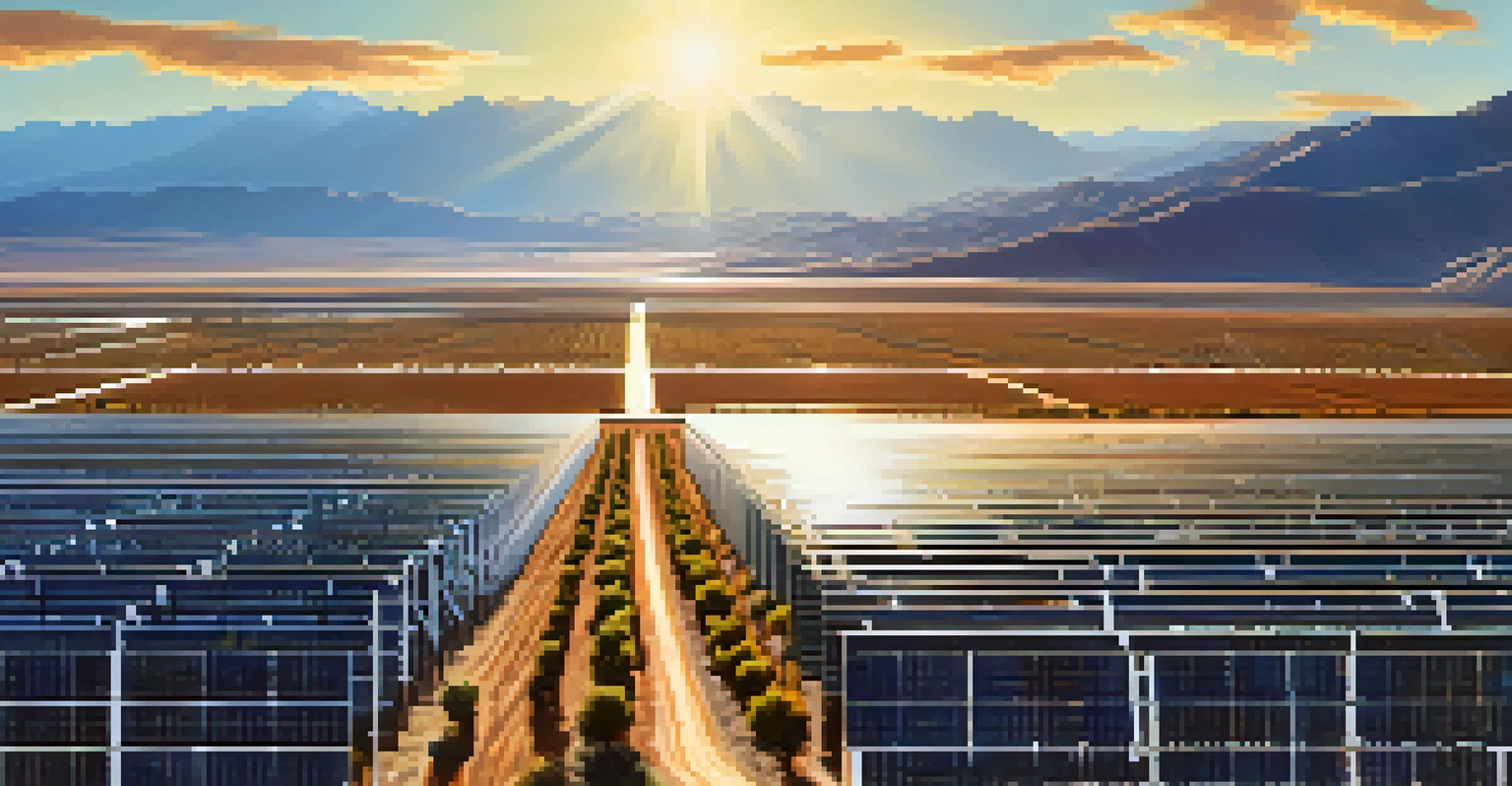The Importance of Infrastructure Investment in Nevada's Growth

Understanding Infrastructure Investment in Nevada
Infrastructure investment refers to the funding and development of essential services and facilities that support the economy. In Nevada, this encompasses everything from transportation networks to utilities and public buildings. Such investments are crucial as they provide the backbone for commerce, tourism, and everyday living.
Investing in infrastructure is not only about building roads and bridges; it's about building the economy and the future of our communities.
For example, improved roads and highways not only facilitate easier travel for residents but also attract businesses seeking efficient logistics. When companies can move goods quickly, it enhances their operations and boosts the local economy. Simply put, a well-planned infrastructure is like a sturdy foundation for a house—it supports everything built upon it.
Furthermore, infrastructure investment often leads to job creation. As projects like building new highways or renovating public transport systems get underway, they require a skilled workforce. This not only provides immediate employment opportunities but also fosters long-term economic stability for the region.
Economic Growth Driven by Infrastructure
Nevada's economy has experienced significant growth in recent years, and infrastructure investment plays a pivotal role in this expansion. By enhancing transportation systems, the state increases its attractiveness to businesses and tourists alike. A robust infrastructure allows for smoother trade and travel, directly impacting the economy's health.

Consider the expansion of the Las Vegas Convention Center, which has been a catalyst for tourism and business events. This infrastructure upgrade has allowed Nevada to host larger conventions, drawing in visitors and their spending power. As more people flock to these events, local businesses thrive, creating a ripple effect of economic benefits.
Infrastructure Drives Economic Growth
Investments in Nevada's infrastructure enhance transportation and utilities, attracting businesses and boosting the local economy.
Moreover, investments in renewable energy infrastructure, like solar farms and wind energy projects, position Nevada as a leader in sustainable energy. This not only attracts environmentally-conscious companies but also creates jobs in emerging industries, showcasing how infrastructure can drive economic growth while promoting sustainability.
Enhancing Quality of Life Through Infrastructure
Infrastructure investment is not just about economic benefits; it also significantly enhances the quality of life for residents. Reliable public transportation, for instance, ensures that everyone has access to jobs, education, and essential services, making daily life more manageable. When people have efficient ways to commute, it reduces stress and contributes to overall well-being.
Infrastructure investment is a key driver of economic growth, creating jobs and enhancing the quality of life for all citizens.
Additionally, well-maintained parks and recreational facilities foster community engagement and promote healthy lifestyles. Investing in these public spaces creates a sense of belonging and improves mental health, as residents have places to gather, relax, and enjoy nature. This investment in community infrastructure is an investment in the people who live there.
Furthermore, improved infrastructure can lead to better emergency services. With efficient road networks and access to utilities, first responders can operate more effectively, ultimately saving lives. This practical aspect of infrastructure underscores its importance in not just supporting the economy but also in safeguarding the community.
Attracting Investment Through Infrastructure Development
A strong infrastructure system is a magnet for investment. When businesses assess the potential of a location, they often look for reliable transportation, communication, and utility systems. Nevada’s commitment to improving its infrastructure signals to investors that the state is serious about fostering a business-friendly environment.
For instance, the development of the Reno-Tahoe International Airport has made the region more accessible, encouraging airlines to offer more flights. This increased connectivity not only benefits travelers but also entices businesses that rely on robust transport links. The airport's growth exemplifies how strategic infrastructure investments can attract both businesses and tourists.
Quality of Life Through Infrastructure
Reliable public services and community spaces improve residents' well-being and foster a sense of belonging.
Moreover, state and local governments can leverage federal funding for infrastructure projects, amplifying their impact. By taking advantage of such opportunities, Nevada can further enhance its infrastructure, making it even more appealing to potential investors. This cycle of investment and improvement creates a thriving economic ecosystem.
Challenges to Infrastructure Investment in Nevada
Despite the clear benefits, Nevada faces several challenges regarding infrastructure investment. Budget constraints and competing priorities can hinder the development of essential projects. With limited state funds, decision-makers must often choose between immediate needs and long-term benefits, complicating the investment landscape.
Additionally, rapid population growth can strain existing infrastructure. As more people move to Nevada, the demand for housing, roads, and public services increases, sometimes outpacing the state’s ability to deliver. This imbalance can lead to congestion, inadequate public services, and a decline in quality of life if not managed properly.
To address these challenges, proactive planning and collaboration among stakeholders are essential. Engaging the community in discussions about infrastructure needs can help prioritize projects that will have the most significant impact. By working together, Nevada can overcome obstacles and ensure that its infrastructure keeps pace with its growth.
The Role of Technology in Infrastructure Development
Technology is transforming how infrastructure is developed and maintained in Nevada. Smart city initiatives, which incorporate technology into urban planning, are becoming more prevalent. For instance, traffic management systems that use real-time data can optimize flow and reduce congestion, making everyday travel easier for residents.
Moreover, advancements in construction technology allow for more efficient building processes. Techniques like 3D printing and modular construction can speed up project timelines while reducing costs. This means that essential infrastructure can be delivered more quickly, addressing community needs in a timely manner.
Technology Enhances Infrastructure
Smart technologies streamline infrastructure development and maintenance, ensuring efficient and sustainable growth.
Furthermore, technology aids in the maintenance of existing infrastructure. Predictive analytics, for example, enables authorities to identify potential issues before they escalate into significant problems. By utilizing technology effectively, Nevada can enhance the longevity and reliability of its infrastructure investments.
Future Trends in Infrastructure Investment for Nevada
Looking ahead, Nevada’s infrastructure investment landscape is poised for exciting developments. As sustainability becomes a priority, there will likely be a shift toward green infrastructure projects. This could include enhanced public transportation systems, solar energy initiatives, and water conservation efforts, all aimed at promoting a more sustainable future.
Additionally, with the rise of remote work, infrastructure investments may focus on improving digital connectivity. Expanding high-speed internet access to rural areas can help bridge the digital divide, ensuring that all Nevadans can participate in the economy regardless of their location. This trend highlights the importance of adapting infrastructure to meet changing societal needs.

Ultimately, the future of infrastructure investment in Nevada will depend on collaboration among government, businesses, and communities. By working together, stakeholders can create a strategic vision that will guide the state’s growth for years to come. This collaborative approach will ensure that Nevada continues to thrive while meeting the needs of its residents.